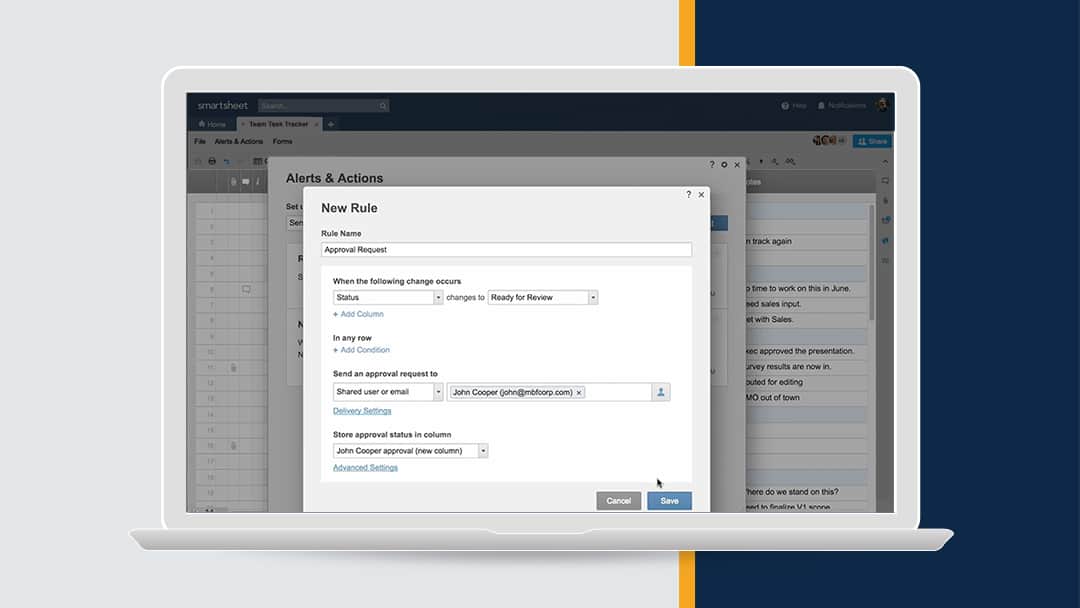Everyone has heard the saying, “If only I had one more hour in the day.” Often we’re the ones saying it. Those of us with full lives know the value of an hour, and are always looking for ways to make the most of our time. Well, I’m excited to share a story with you about how I spent five minutes over the summer setting up Smartsheet automated actions and how doing so has saved me an hour each workday since.
A Manual Process Keeps Me Up At Night
Over the summer, I realized — after work hours — that I had forgotten to perform a task that others relied on, so I needed to sacrifice personal time to do so. We’ve all been there. We give up family time, dinner, kid’s sporting events, spin class, or even a relaxing night, to make sure work processes are running smoothly. In my case, I interrupted my sleep on a red-eye flight from Boston to Seattle to assign sales engineering resources to our sales representatives.
Let me explain. I manage one of Smartsheet’s sales engineering teams, and it’s my team’s responsibility to provide technical sales support for any rep who requests assistance. From basic product Q&As to complex proofs of concepts, sales reps can request help from my team, and they’ll receive it — if they meet minimum requirements. At the time of my red-eye flight, our request process looked something like this:
- A sales rep requests sales engineering support on their sales opportunities through a form.
- Smartsheet gathers the request form data into the Sales Engineering Assignment Backlog Queue.
- The sales engineering manager reviews the request to ensure its validity, with the following in mind:
- Is the information provided accurate and complete?
- Is the deal up to date?
- Does the request meet the minimum threshold requirements?
- The sales engineering manager confirms how long the rep has been with Smartsheet. (We provide additional support for newer reps who are still in training.)
- If any information is missing, the sales engineering manager reaches out to the sales manager and the sales rep over instant messaging, email, or a phone call to discuss what’s missing.
- The sales engineering manager receives responses sporadically throughout the day and manually enters answers into the sheet.
- Once data has been entered, the request is complete and sales engineering manager is ready to assign resources.
Due to the volume of requests from a team of over 100 sales reps, my time spent managing this process was totaling over an hour per day, not to mention the time taken away from my team in stand up meetings to triage the process as needed.
Related Report
The State of Automation Survey
An Airborne Insight to Automate
That night on the plane — 40k feet in the air — I realized that Smartsheet could not only manage this process on my behalf, but it could do it more efficiently than I could.
How? I could automate our process, to ensure we had the necessary information from our sales team, and more quickly react to requests. Smartsheet automated actions make it easy to automate notifications, update requests, and approval requests, without a single line of code, complex formulas, or help from IT.
So in 5 minutes, mid-flight, I set up the following rules in the sheet:
- Send an automated notification: If the opportunity amount reflects $0, notify the rep (from the contact list column) that they will receive an assigned resource only once they have updated the opportunity with a dollar value.
- Send an automated approval request: If the request is under our minimum support threshold, send an approval request to the sales rep’s manager (from the contact list column) to approve/disapprove a support exception.
- Send an automated update request: If the request is missing any contextual fields describing what they need, send an update request to the sales rep (contact list column) to request the additional information.
- Set conditional rules for automated actions: If the sales rep is under 2 months tenure (still in training), disregard above and accept all requests.
Our New Automated Process
The four actions above essentially removed all of my effort in the process prior to assigning my resources to opportunities. The new process now operates as follows:
- A sales rep requests sales engineering support on their sales opportunities.
- Smartsheet pulls the request into SE Assignment Backlog Queue.
- Smartsheet automatically checks to see that:
- Request information is complete
- Deal is current
- Request meets minimum thresholds requirements
- Smartsheet confirms rep’s tenure for trainee exceptions.
- If any information is missing, Smartsheet reaches out to the sales manager or sales rep for approval exception or additional information respectively.
- Responses are populated back into the sheet by Smartsheet automatically.
- Everything is now ready to assign resources.
I spent about five minutes setting up the automated actions I put in place to make this process run on its own. With Smartsheet performing the above tasks on my behalf, I save an hour of manual effort every day.
Related
Can Automation Improve Employee Engagement?
What Can Automation Do for You?
How much time do you spend emailing, calling, or chatting back and forth with your customers, employees, and coworkers? How many administrative steps do you deal with on a daily basis that could be automated? Collecting data, requesting updates, requesting approvals, and notifying stakeholders can all be automated with Smartsheet, so I hope you have an idea what you would do with the extra hour — or more — you get back each day.
As for me, I’ll be sleeping on my next red eye. Don’t tell my boss...
Want to learn more? Watch this video to find out more about automated workflows.

